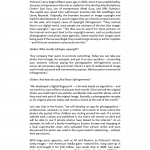Why Real Estate is the Next Industry to be Hit By Artificial Intelligence
Buying a home conjures a cocktail of emotions. Plus, most buyers have already concocted a list of requirements before they’ve even began their search. They’ve got to have a connection with the property, its look and feel, it has to be within their budget, located in their preferred neighborhood, and so on. As the real estate industry focuses primarily online, much of the emotion is dampened. And this is where artificial intelligence (AI) kicks in.
Real estate searches start at Google rather than at the realtor’s office. While 80% of all home buyers are house hunting online, more than 83% of all home buyers want to see pictures of the property before they check it out in person. And since they already have an idea of how they’d like their future home to look, AI-driven Visual Search has the potential to be a game-changer in real estate listings.

Why Would This Tech Shape the Real Estate Industry?
Visual Search allows home buyers to browse properties by visual similarities — because more often than not, words aren’t enough to describe what we like about a house. The usual filters remain in place (budget, neighborhood, number of rooms, etc), but when the buyer has visual control over their choices, the results soon match their initial list of requirements.
Ideally, this AI-driven computer vision can identify specific locations within a property ( eg. backyard swimming pool), objects within a property (eg. fireplace), or materials (eg. wooden floors). Let’s say a buyer wanted to see every property featuring an ‘open plan kitchen’ with a predominantly white color theme/floor tiles within a particular neighborhood. Rather than scrolling through every real estate listing for that zip code, artificial intelligence and Visual Search would bring up a range of options for the buyer to peruse and perhaps consequently purchase.

Step-by-Step Process of Artificial Intelligence’s Impact
How do these visuals reflect a buyer’s visual preferences? The first step happens when the visuals are uploaded into the real estate portal — image recognition technology assists in automatically tagging the images, helping to sort through them when required. The next step is when the buyer requests these images as they browse visually — the portal then offers a range of visually similar listings based on those tags and the buyer’s visual preferences.
In teaching computers to see, the entire world has become a showroom. And as buyers are bombarded with visual content from every direction, it’s never been more important for real estate portals to take advantage of their ever-growing bank of visual assets. Applying image recognition technology to their front (buyer) and back (seller) ends also gives them a competitive edge in growing their user base.
Improving the Behind-the-Scenes’ Flow of Real Estate Portals
We’ve already looked how AI-driven computer vision helps buyers in the front-end of real estate portals — let’s have a look at how it can streamline the back-end for sellers wanting to post visuals of their properties. Functions like Visual Search helps sellers determine if certain images were uploaded before and are already online, thus avoiding duplicating content. Another function that can help sellers cut down time-consuming mechanical tasks is suggested auto-tagging. Suggested auto-tagging labels your images with appropriate keywords and are then part of your image metadata. At this stage, the technology helps speed up the process by labeling submissions and learning from every upload.
Customizing Your House Hunting with AI
Buyers are spending more time online doing research and want to see visuals of the homes they’re interested in — long before they even consider going to see it in person. It’s essential for real estate portals to capitalize on the wealth of visual data they have at their fingertips and provide a more visual experience for both their buying and selling customer-base.
In this way, PicScout’s Visual API is the ideal image recognition technology for real estate portals to enhance their customer experience. Learn more here on the different applications of PicScout’s AI-driven computer vision, and contact us for more information on how to make the most of your visual assets in the real estate industry.





